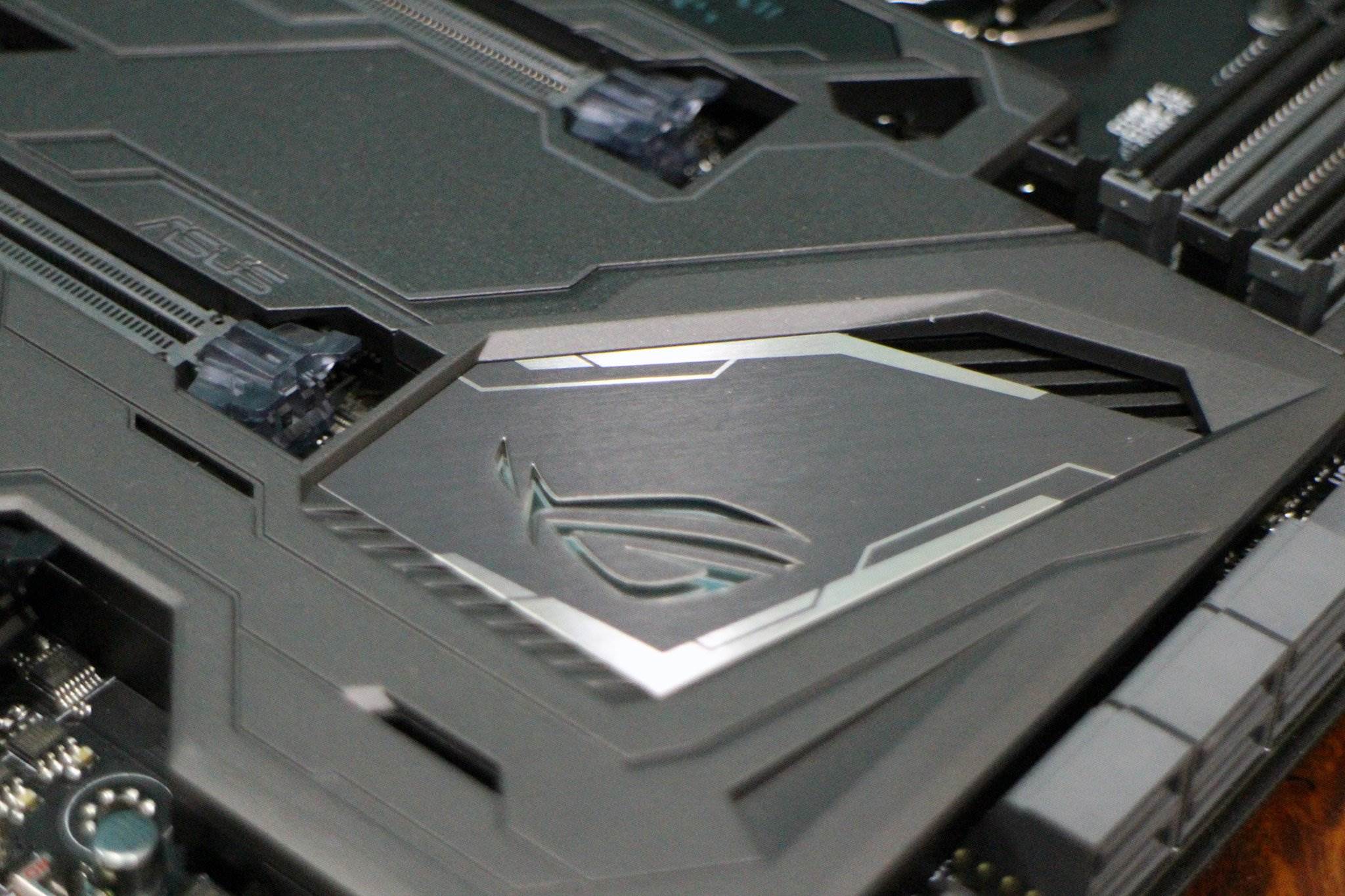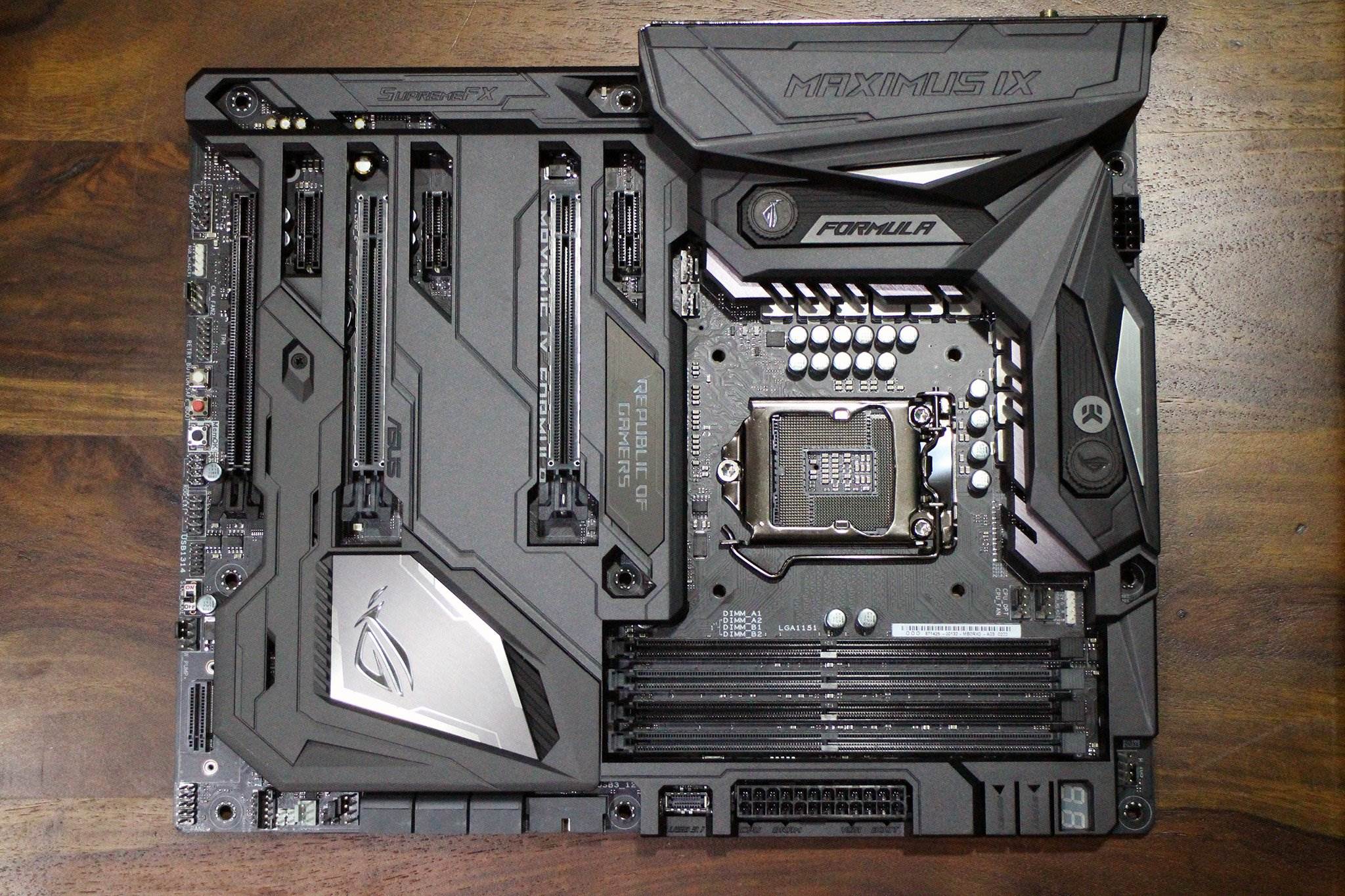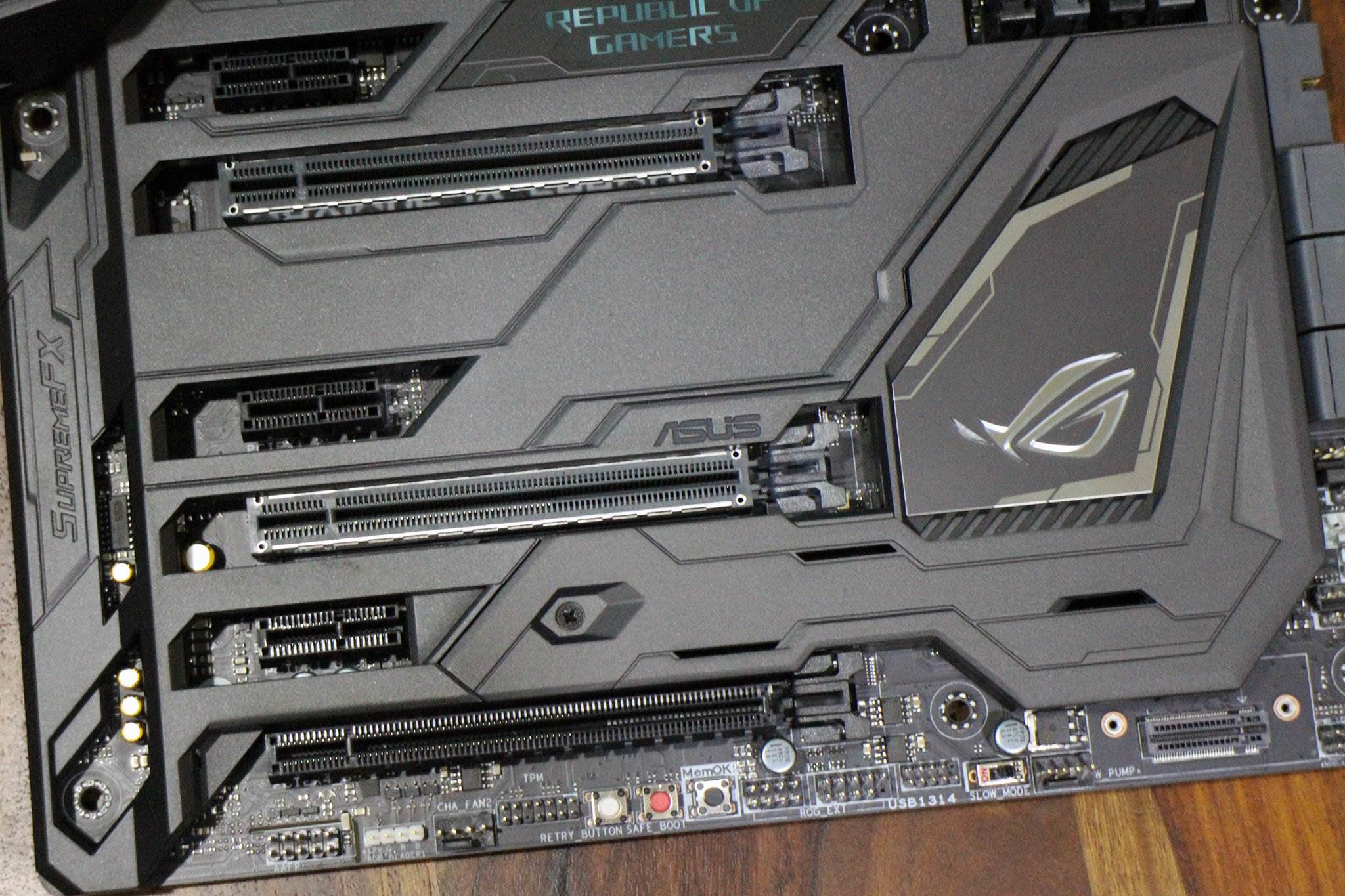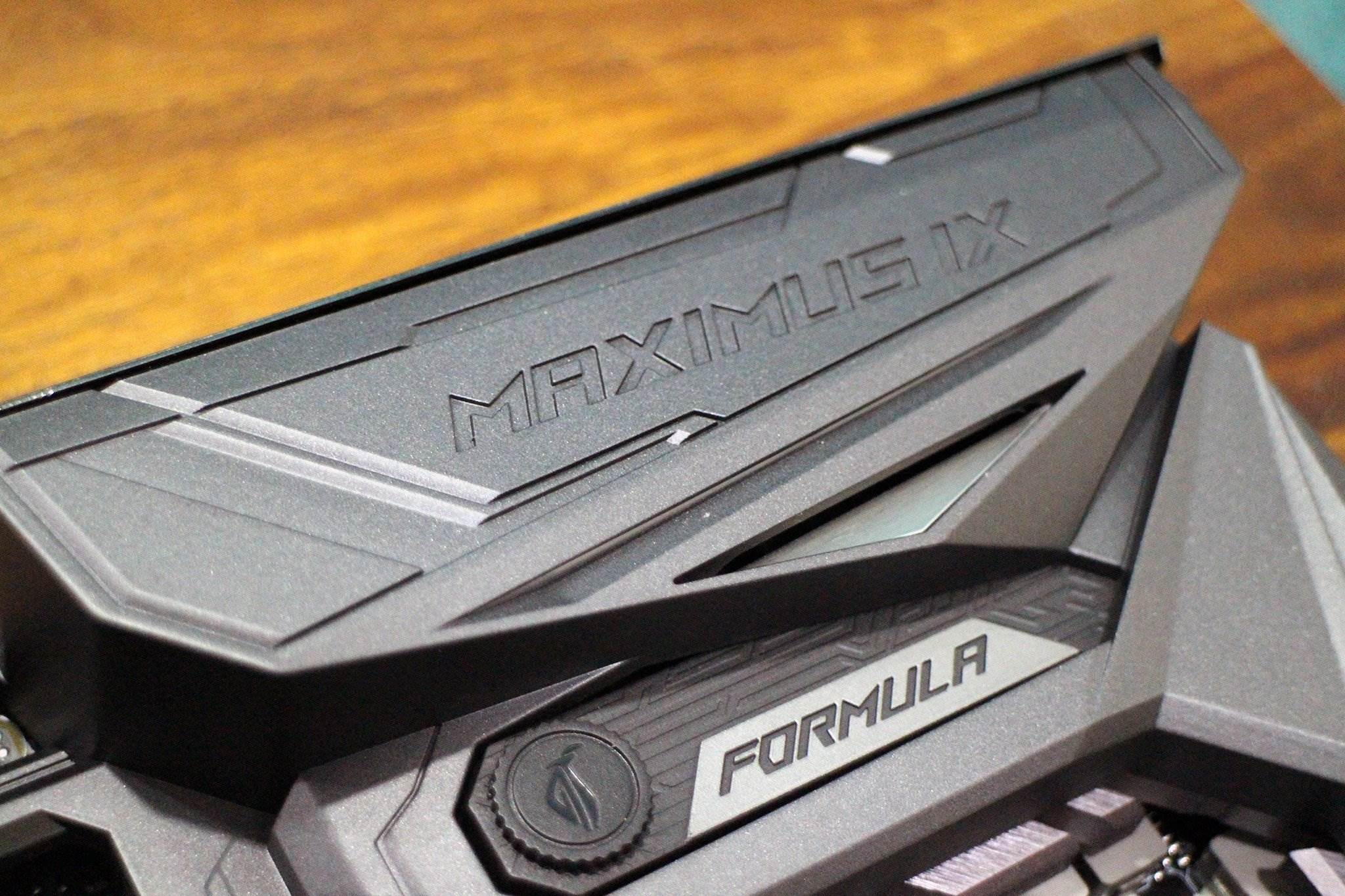Intel unveiled its seventh-generation Kaby Lake processors late last week, introducing a new Z270 chipset as well. To tie in with the launch of the new processors, we’re now seeing a bevy of new motherboards based on the Z270 platform. Today, we’re taking a look at ASUS’ Maximus IX Formula, a high-end board targeted at gamers and overclockers.
The Maximus line has always signified exuberance, with ASUS going out of its way to include everything you’d want — and a few features most users would never use — in a bid to cater to its core audience of gamers. That’s no different in the Maximus IX Formula: the motherboard has a grey color scheme with red accents throughout, there are several software-customizable LEDs that allow you to match up the look of the board with the rest of your chassis, and you can even 3D-print accessories to attach to the board. There’s also a USB 3.1 header on the board itself, paving the way for a USB-C front connector.
Overall, there’s a lot to be excited about in the Maximus IX Formula. Before we delve in, a look at what’s new with Kaby Lake and the Z270 platform.
Kaby Lake and Z270

Kaby Lake is Intel’s first processor that breaks away from the tick-tock cycle. Instead of architectural improvements or a new process node, we’re being treated to what Intel calls the “process-architecture-optimization” model. Kaby Lake is the third generation on the 14nm cycle, and serves to fill out Intel’s product portfolio while we await the switch to the 10nm Cannonlake, due sometime next year.
Intel is touting the newer 14nm fabrication process (14FF+) as offering added gains in clock speeds, with the Core i7-7700K offering a base clock of 4.2GHz and a turbo clock of 4.5GHz, a modest increase over Skylake’s i7-6700K with a base of 4.0GHz and boost of 4.2GHz. Intel has also tweaked its algorithms to allow faster clock speed changes.
Kaby Lake uses the same LGA1151 socket as Skylake, so you can slot in a Kaby Lake processor in a Z170 board or a Skylake CPU on the newer Z270 boards. However, there are a few features that require both a Kaby Lake CPU and a Z270 board, like 4K streaming.
The Intel Graphics 630 iGPU offers 4K HEVC 10-bit encode and decode as well as VP9 decode, HDR video, and wide color gamut. Kaby Lake makes more sense on notebooks because of the 10-bit video engine. One reason you couldn’t stream 4K content on Skylake was the lack of Microsoft’s PlayReady 3.0 DRM certification. Kaby Lake is certified on account of hardware-accelerated HEVC 10-bit decode, but the downside is that you can only stream 4K using Microsoft’s Edge browser on Windows 10 Anniversary Update.
So if you’re looking to get a notebook and are interested in streaming content, then Kaby Lake is a better choice. But if you’re in the enthusiast segment and are deciding between the latest CPUs and those that are now a generation old, the choice is much less clear.
The Z270 platform also offers new features in the form of 24 PCIe 3.0 lanes, official compatibility for DDR4-2400 RAM and Intel’s Optane as-yet-unannounced storage products.
Maximus IX Formula specs
|
CPU |
Intel Socket 1151 for 7th/6th Generation Core i7/Core i5/Core i3/Pentium/Celeron Processors
Supports Intel 14 nm CPU Supports Intel Turbo Boost Technology 2.0 |
|
Chipset |
Intel Z270 |
|
Memory |
4 x DIMM, Max. 64GB, DDR4
4133(O.C.)/4000(O.C.)/3866(O.C.)/3733(O.C.)/3600(O.C.)/3466(O.C.)/3400(O.C.) 3333(O.C.)/3300(O.C.)/3200(O.C.)/3000(O.C.)/2800(O.C.)/2666(O.C.)/2400(O.C.)/2133(O.C.) MHz Non-ECC, Un-buffered Memory Dual Channel Memory Architecture Supports Intel Extreme Memory Profile (XMP) |
|
Graphic |
Integrated Graphics Processor
Multi-VGA output support: HDMI/DisplayPort ports – Supports HDMI with max. resolution 4096 x 2160 @ 24 Hz – Supports DisplayPort with max. resolution 4096 x 2304 @ 60 Hz Maximum shared memory of 1024 MB |
|
Multi-GPU Support |
Supports NVIDIA 2-Way SLI Technology
Supports AMD 3-Way CrossFireX Technology |
|
Expansion Slots |
2 x PCIe 3.0/2.0 x16
1 x PCIe 3.0/2.0 x16 3 x PCIe 3.0/2.0 x1 |
|
Storage |
Intel Z270 Chipset:
1 x M.2 Socket 3, with M key, type 2242/2260/2280 storage devices support (SATA & PCIE 3.0 x 4 mode) 1 x M.2 Socket 3, with M key, type 2242/2260/2280/22110 storage devices support (PCIE 3.0 x 4 mode) 6 x SATA 6Gb/s port(s) Intel Optane Memory Ready Raid 0, 1, 5, 10 |
|
LAN |
Intel I219V
Anti-surge LANGuard ROG GameFirst Technology |
|
Wireless Data Network |
Wi-Fi 802.11 a/b/g/n/ac Supports dual band frequency 2.4/5 GHz Supports MU-MIMO |
|
Audio |
ROG SupremeFX 8-Channel High Definition Audio CODEC S1220
– Impedance sense for front and rear headphone outputs |
|
USB Ports |
ASMedia USB 3.1 controller:
1 x USB 3.1 front panel connector port(s) ASMedia USB 3.1 controller: 2 x USB 3.1 port(s) (2 at back panel, , Type-A + Type-C) Intel Z270 Chipset: 6 x USB 3.0 port(s) (4 at back panel, blue, 2 at mid-board) Intel Z270 Chipset: 6 x USB 2.0 port(s) (4 at back panel, black, 2 at mid-board) |
|
ROG Exclusive Features |
CrossChill EK (Hybrid air and liquid cooling) ROG Armor (including top cover and SECC steel backplate) ROG RAMCache II ROG CloneDrive Pre-mounted I/O Shield MemOK! Button CMOS button ReTry Button Safe Boot Button Start Button Reset Button LN2 Mode GameFirst IV ROG Aura – Aura Lighting Control – Aura RGB Strip Headers Extreme Engine Digi+ : – MicroFine Alloy Chokes – NexFET™ Power Block MOSFET – 10K Black Metallic Capacitors KeyBot II – X.M.P. – ClrCMOS – Power On UEFI BIOS features : – O.C. Profile – Tweakers’ Paradise – ROG SSD Secure Erase – Graphic Card Information Preview ROG RAMDisk Extreme Tweaker BIOS Flashback |
|
Special Features |
ASUS Dual Intelligent Processors 5-Way Optimization by Dual Intelligent Processors 5 : – 5-Way Optimization tuning key perfectly consolidates TPU, EPU, DIGI+ VRM, Fan Xpert 3, and Turbo App ASUS Exclusive Features : – MemOK! – AI Suite 3 – Ai Charger ASUS EZ DIY : – ASUS CrashFree BIOS 3 – ASUS EZ Flash 3 – ASUS USB BIOS Flashback ASUS Q-Design : – ASUS Q-Code – ASUS Q-LED (CPU, DRAM, VGA, Boot Device LED) – ASUS Q-Slot – ASUS Q-DIMM – ASUS Q-Connector Overclocking Protection : – ASUS C.P.R.(CPU Parameter Recall) |
|
Back I/O Ports |
1 x DisplayPort
1 x HDMI 1 x LAN (RJ45) port(s) 1 x USB 3.1 (black)Type-C 1 x USB 3.1 (red)Type-A 4 x USB 3.0 (blue) 4 x USB 2.0 (one port can be switched to USB BIOS Flashback) 1 x Optical S/PDIF out 1 x Clear CMOS button(s) 1 x USB BIOS Flashback Button(s) |
|
Internal I/O Ports |
2 x Aura RGB Strip Headers 1 x USB 3.0 connector(s) support(s) additional 2 USB 3.0 port(s) 1 x USB 2.0 connector(s) support(s) additional 2 USB 2.0 port(s) 1 x M.2 Socket 3 with M Key, type 2242/2260/2280/22110 storage devices support (SATA mode & X4 PCIE mode) 1 x M.2 Socket 3 with M Key, type 2242/2260/2280 storage devices support (PCIE mode only) 1 x TPM connector(s) 6 x SATA 6Gb/s connector(s) 1 x CPU Fan connector(s) (1 x 4 -pin) 1 x CPU OPT Fan connector(s) (1 x 4 -pin) 3 x Chassis Fan connector(s) (3 x 4 -pin) 1 x H_AMP fan connector 1 x W_PUMP+ connector (1 x 4 -pin) 1 x AIO_PUMP connector (1 x 4 -pin) 1 x 24-pin EATX Power connector(s) 1 x 8-pin ATX 12V Power connector(s) 1 x Front panel audio connector(s) (AAFP) 1 x System panel(s) (Q-Connector) 1 x MemOK! button(s) 1 x Slow Mode switch(es) 1 x Reset button(s) 1 x LN2 Mode jumper(s) 1 x ROG extension (ROG_EXT) header(s) 1 x Safe Boot button 1 x ReTry button 1 x EXT_Fan header 1 x W_IN header 1 x W_OUT header 1 x W_FLOW header 1 x Thermal sensor connector 1 x Start button 1 x USB 3.1 front panel connector |
|
BIOS |
1 x 128 Mb Flash ROM, UEFI AMI BIOS, PnP, DMI3.0, WfM2.0, SM BIOS 3.0, ACPI 6.0, Multi-language BIOS, ASUS EZ Flash 3, CrashFree BIOS 3, F11 EZ Tuning Wizard, F6 Qfan Control, F3 My Favorites, Last Modified log, F12 PrintScreen, F3 Shortcut functions and ASUS DRAM SPD (Serial Presence Detect) memory information. |
|
Operating System |
Windows 10 64-bit
Windows 8.1 64-bit Windows 7 32-bit Windows 7 64-bit |
|
Form Factor |
ATX Form Factor 12 inch x 9.6 inch ( 30.5 cm x 24.4 cm ) |
Maximus IX Formula overview

The Maximus IX Formula sports an interesting grey-on-black paint scheme, and instead of overlaying accent colors on the board itself (there’s a lot of red around the rear I/O), ASUS went with its Aura RGB LED lighting scheme.
Although the base design of the motherboard is understated, the reinforced elements make it look very chic. The PCH heatsink and the shroud over the rear I/O come with a brushed-metal look, and the reinforced design makes the board stand out. The LEDs are housed underneath the shroud and the heatsink, and the design of the board allows the light to shine through.
We’ve seen Aura lighting in the Strix 1080, and much like the video card, the lighting scheme is very well implemented here. It isn’t subtle as quite a lot of light comes through from the various seams, but it is not ostentatious either. Aura includes several effects: breathing, color cycle, strobe, rainbow, flash, comet, or always-on. You can also customize the color to your CPU’s temperature, or sync the lighting scheme to your playlist. If you’ve also got a Strix video card with Aura lighting enabled or any of ASUS’ accessories, you can have all of them display the same lighting effects.

The Maximus IX Formula has eight PWM fan headers in total, and all of them can be monitored and controlled via ASUS’ Fan Xpert 4. You also get Extreme Quiet Mode, through which you can set the CPU and chassis fans to go silent for low-power tasks. There’s a Water-Cooling Zone as well that offers two…






